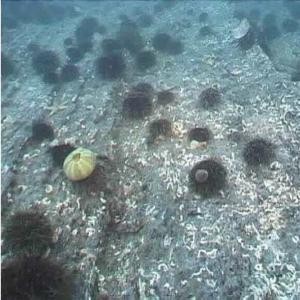by Trond R. Oskars
Many species and Biodiversity (1) as a whole is currently under a lot of pressure, not only climate change (2, 3, 4), but also increased direct interference by humans (5, 6, 7, 8, 9). This may lead to extinction events, severe shifts in species interactions and ecosystem composition (10, 11, 12). Due to this assessing current and past biodiversity and understanding their interactions and responses to stressors have become more important to try to predict the outcome of the ongoing human driven change of the biosphere (13, 14).
It is a known problem that there are large gaps in the fossil record (14), the older the rocks the bigger the chance that older fossils will not survive to be discovered and cannot be expected to match the diversity represented in more recent fossil assemblages (14, 15, 16). However the fossil record can still tell us a lot about long time stability of organism groups and ecosystems (14, 16), thus gives us the board picture of the effect of stressors comparable to human actions. However for a more detailed view we need data from living species (14).
Here we encounter an additional problem the lack of knowledge of extant species of many groups. About 1.2 to 1.9 million species have been formally described and given a name (17, 18). The number of species that currently exist in the world (not counting bacteria and their kin) varies by the method used, but is has been estimated as high as 8.7 million (18, 19). This leaves the majority (over 80%) of all species unknown or unnamed (20).
This opens for the possibility that species may fail to be recognized, discovered or described before being driven to extinction (13, 18). Even for relatively well known ecosystems (tropical forests) and well-studied animals (vertebrates; amphibians) there are likely still undiscovered species (18, 21, 22, 23, 24). This means that the number of undescribed species may be even higher for unexplored or inaccessible areas or taxa[1].
This also means that we in most cases know little about their roles in the ecosystem, how they interact with other species, and how the extinction may affect the ecosystem as whole.
Describing species takes a long time, averagely 21 years! (20). Much due to the shortage of taxonomists and that most species are rare and only represented by single specimens, leading to many researchers waiting until they have more specimens available[2] (20, 25). Museum collections are reservoirs of many undescribed species, sampled in bulk on long ago expeditions and many of which may already be extinct (20). Another factor is that most taxonomists don’t live in developing countries where Biodiversity is highest (20, 26). Many species can also be relatively well known by those who do live there (23), but have never been formally described or studied in other contexts. If no one has studied a species, how can we know if it is a common, widespread species or a group of similar endemic species? This is especially problematic in cases where their most well-known quality is that they are especially tasty with soy sauce (27*[3]).

How to get the impotance of proper taxonomy out to locals and legislator?
There is an additional dimension to this, what about the already described species? Does everybody agree on what a species is? (This is even further complicated by species concepts).
The problem is how we define what a species is, the method used, and the disagreement between these. Many taxonomists and sytematicists rely either on morphology or DNA to define species. Either they don’t trust one method, or they don’t have a choice, like paleontologists (28) or those researching cryptic species[4] (29).
However, In some cases convergent evolution[5] can make unrelated taxa that have some habits or habitats in common to seem closely related by morphology (30, 31) or populations that seem identical may in fact be evolutionary distinct (32) This may lead to conflict between methods and lead to bad taxonomy in the form of wrongful synonyms[6] (many taxa lumped into one) or undiscovered synonyms (one taxa counted as several). Mora et al. (18) asked 2938 taxonomists about what they felt could limit taxonomic effort[7], most answered synonyms as a major problem on the species level even if did not affect higher taxonomic levels drastically. So likely the general trends in taxa response to stressors can be trusted, but on the species level this resolution may be lacking.
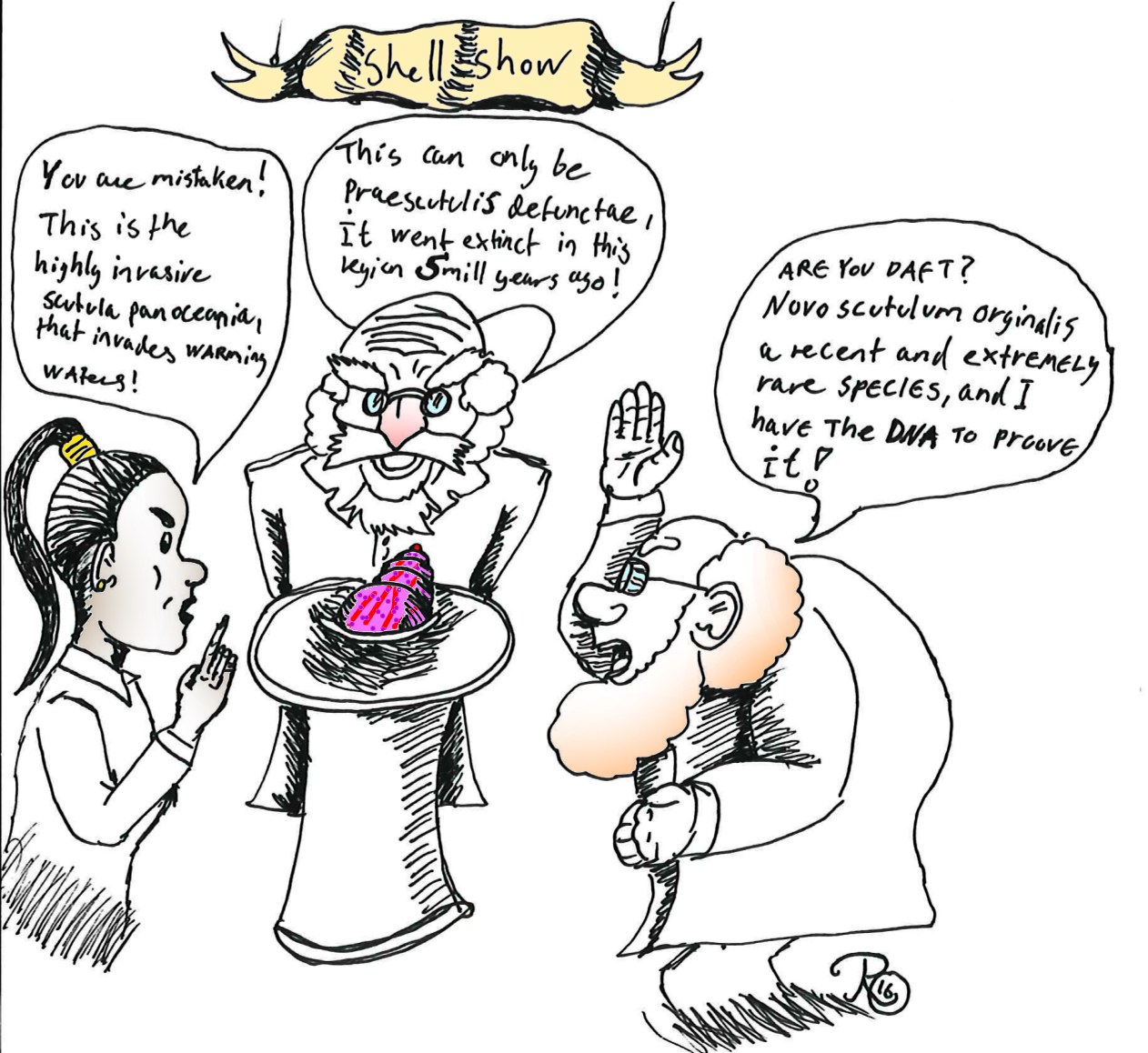
How to define speices can wary form disiplines to the methods used within the disiplines.
This can be highly problematic in conservation of Biodiversity and ecosystem services. A study by Prie et al. (33) on the freshwater clams Unio in Europe, found three distinct species and several distinct sub species based on DNA. This group is riddled with synonyms based on morphology, which has impacted the conservation status of the species, leading to some of the groups to be isolated and population reduced due to human activities (33).
This lack of knowledge is dangerous as it reduces our ability to conserve species or communities that may be potentially important for ecosystem function (24, 33, 34, 35). Additionally, if enough species are not properly recognized we cannot see the complete picture of biodiversity patterns or estimate extinction rates (21, 24). It also makes it difficult to transform the scientific data into information that can be used by legislators who decide on conservation and the people who actually live alongside the species (however some manage *).
We stand to lose important ecosystem processes and services that may in turn harm other species, or even come to affect human populations (21, 34, 36, 37). Basically we don’t really know what we have lost until it is gone. Due to this it would beneficial not only to protect areas that we know to be especially biodiverse, but also areas that are relatively unexplored or less disturbed by humans, as there are likely a high diversity of undescribed species there (24).
References
- Wilson, E. O. (1988). The current state of biological diversity. In Biodiversity, E.O. Wilson & F.M. Peters, (Eds). 3-18 PP. Washington, DC: National Academy Press. Accessed at http://www.ncbi.nlm.nih.gov/books/NBK219273/ at 20.02.16
- Walther, G. R., Post, E., Convey, P., Menzel, A., Parmesan, C., Beebee, T. J., et al., & Bairlein, F. (2002). Ecological responses to recent climate change. Nature, 416(6879), 389-395.
- Walther, G. R. (2010). Community and ecosystem responses to recent climate change. Philosophical Transactions of the Royal Society of London B: Biological Sciences, 365(1549), 2019-2024.
- Parmesan, C. (2006). Ecological and evolutionary responses to recent climate change. Annual Review of Ecology, Evolution, and Systematics, 637-669.
- Alongi, D. M. (2002). Present state and future of the world’s mangrove forests. Environmental conservation, 29(03), 331-349.
- Stuart, S. N., Chanson, J. S., Cox, N. A., Young, B. E., Rodrigues, A. S., Fischman, D. L., & Waller, R. W. (2004). Status and trends of amphibian declines and extinctions worldwide. Science, 306(5702), 1783-1786.
- Brook, B. W., Sodhi, N. S., & Bradshaw, C. J. (2008). Synergies among extinction drivers under global change. Trends in Ecology & Evolution, 23(8), 453-460
- Butchart, S. H., Walpole, M., Collen, B., Van Strien, A., Scharlemann, J. P., Almond, R. E, et al. & Carpenter, K. E. (2010). Global biodiversity: indicators of recent declines. Science, 328(5982), 1164-1168.
- Polidoro, B. A., Carpenter, K. E., Collins, L., Duke, N. C., Ellison, A. M., Ellison, J. C., et al. & Livingstone, S. R. (2010). The loss of species: mangrove extinction risk and geographic areas of global concern. PloS one, 5(4), e10095.
- Vitousek, P. M., Mooney, H. A., Lubchenco, J., & Melillo, J. M. (1997). Human domination of Earth’s ecosystems. Science, 277(5325), 494-499.
- Chapin III, F. S., Zavaleta, E. S., Eviner, V. T., Naylor, R. L., Vitousek, P. M., Reynolds, H. L., et al. & Mack, M. C. (2000). Consequences of changing biodiversity. Nature, 405(6783), 234-242.
- Van der Putten, W. H., Macel, M., & Visser, M. E. (2010). Predicting species distribution and abundance responses to climate change: why it is essential to include biotic interactions across trophic levels. Philosophical Transactions of the Royal Society of London B: Biological Sciences, 365(1549), 2025-2034.
- Stork, N. E. (1993). How many species are there?. Biodiversity & Conservation, 2(3), 215-232.
- Blois, J. L., Zarnetske, P. L., Fitzpatrick, M. C., & Finnegan, S. (2013). Climate change and the past, present, and future of biotic interactions. Science, 341(6145), 499-504.
- Raup, D. M. Taxonomic diversity during the Phanerozoic. Science 177, 1065–1071 (1972).
- Benton, M. J., Wills, M. A., & Hitchin, R. (2000). Quality of the fossil record through time. Nature, 403(6769), 534-537.
- Chapman, A. D. Numbers of living species in Australia and the world. (2009): 1-78 PP. Report for the Australian Biological Resources Study. Canberra, Australia. Available form https://www.environment.gov.au/system/files/pages/2ee3f4a1-f130-465b-9c7a-79373680a067/files/nlsaw-2nd-complete.pdf accessed on 20.02.16.
- Mora, C., Tittensor, D. P., Adl, S., Simpson, A. G., & Worm, B. (2011). How many species are there on Earth and in the ocean?. PLoS Biol, 9(8), e1001127.
- May, R. M. (2011). Why worry about how many species and their loss?. PLoS Biol, 9(8), e1001130.
- Fontaine, B., Perrard, A., & Bouchet, P. (2012). 21 years of shelf life between discovery and description of new species. Current Biology, 22(22), R943-R944.
- Ceballos, G., & Ehrlich, P. R. (2009). Discoveries of new mammal species and their implications for conservation and ecosystem services. Proceedings of the National Academy of Sciences, 106(10), 3841-3846.
- Geissmann, T., Lwin, N., Aung, S. S., Aung, T. N., Aung, Z. M., Hla, T. H., Grindley, M., Momberg, F. (2011). A new species of snub‐nosed monkey, Genus Rhinopithecus Milne‐Edwards, 1872 (Primates, Colobinae), from northern Kachin State, northeastern Myanmar. American Journal of Primatology, 73(1), 96-107.
- Hart, J. A., Detwiler, K. M., Gilbert, C. C., Burrell, A. S., Fuller, J. L., Emetshu, M., Hart, T. B., Vosper, A., Sargis, E. J, Tosi, A. J. (2012). Lesula: a new species of Cercopithecus monkey endemic to the Democratic Republic of Congo and implications for conservation of Congo’s Central Basin. PLoS One, 7(9), e44271.
- Giam, X., Scheffers, B. R., Sodhi, N. S., Wilcove, D. S., Ceballos, G., & Ehrlich, P. R. (2012). Reservoirs of richness: least disturbed tropical forests are centres of undescribed species diversity. Proceedings of the Royal Society of London B: Biological Sciences, 279(1726), 67-76.
- Lim, G. S., Balke, M., & Meier, R. (2012). Determining species boundaries in a world full of rarity: singletons, species delimitation methods. Systematic biology, 61(1), 165-169.
- Gaston, K. J., May, R. M.(1992). Taxonomy of taxonomists. Nature, 356, 281-282.
- Lim K. K. P., Murphy D. H, Morgany, T., Sivasothi, N.,Ng P. K. L. Soong, B. C.,. Tan, H. T. W, Tan, K. S., Tan, T. K. A (1999) Guide to Mangroves of Singapore Peter K. L. Ng and N. Sivasothi (ed). BP Guide to Nature Series published by the Singapore Science Centre, sponsored by British Petroleum. Raffles Museum of Biodiversity Research, The National University of Singapore & The Singapore Science Centre. Online excerpt: http://mangrove.nus.edu.sg/guidebooks/text/2088.htm accessed on 19.02.16
- Kaiser, G., Watanabe, J., & Johns, M. (2015). A new member of the family Plotopteridae (Aves) from the late Oligocene of British Columbia, Canada. Palaeontologia Electronica, 18(3), 1-18
- Jörger, K. M., & Schrödl, M. (2013). How to describe a cryptic species? Practical challenges of molecular taxonomy. Frontiers in Zoology, 10(1), 1.
- May, R. M. (1990). Taxonomy as destiny. Nature, 347(6289), 129-130.
- Oskars, T. R., Bouchet, P., & Malaquias, M. A. E. (2015). A new phylogeny of the Cephalaspidea (Gastropoda: Heterobranchia) based on expanded taxon sampling and gene markers. Molecular phylogenetics and evolution, 89, 130-150.
- Hebert, P. D., Penton, E. H., Burns, J. M., Janzen, D. H., & Hallwachs, W. (2004). Ten species in one: DNA barcoding reveals cryptic species in the neotropical skipper butterfly Astraptes fulgerator. Proceedings of the National Academy of Sciences of the United States of America, 101(41), 14812-14817.
- Prié, V., Puillandre, N., & Bouchet, P. (2012). Bad taxonomy can kill: molecular reevaluation of Unio mancus Lamarck, 1819 (Bivalvia: Unionidae) and its accepted subspecies. Knowledge and Management of Aquatic Ecosystems, (405), 08.
- Suzán, G., Marcé, E., Giermakowski, J. T., Mills, J. N., Ceballos, G., Ostfeld, R. S., Armien, B,. Pascale, J. M.,Yates, T. L. (2009). Experimental evidence for reduced rodent diversity causing increased hantavirus prevalence. PloS one, 4(5), e5461
- Mace, G. M. (2004). The role of taxonomy in species conservation. Philosophical Transactions of the Royal Society of London B: Biological Sciences, 359(1444), 711-719.
- Worm, B., Barbier, E. B., Beaumont, N., Duffy, J. E., Folke, C., Halpern, B. S.,. Jackson J. B. C, Lotze, H. K., Micheli, F., Palumbi, S. R., Sala, E., Selkoe, K. A., Stachowicz, J. J., Watsom, R. (2006). Impacts of biodiversity loss on ocean ecosystem services. Science, 314(5800), 787-790.
- Dugan, P. J., Barlow, C., Agostinho, A. A., Baran, E., Cada, G. F., Chen, D., et al. & Marmulla, G. (2010). Fish migration, dams, and loss of ecosystem services in the Mekong basin. Ambio, 39(4), 344-348.
[1] Taxa- A group of individuals or species that due to one or several methods are seen my Taxonomists or sytematicists to form one discernable unit and given a name.
[2] I have more than once spent two whole days dissecting a specimen less than 1 mm long as it was the only one available.
[3] I am revising the taxonomy of this group, current knowledge is next to none.
[4] Cryptic species- A species that is molecular distinct, but more or less impossible to separate form related species based on morphology.
[5] Convergent evolution- When evolution drives two species that are unrelated to gain a similar morphology, for example due to living in a similar habitat, also possible for related, but not closely related species trough parallel evolution.
[6] Synonymy- Basically when one taxa is regarded as the same as another and the most recent name must be replaced by the oldest available name.
[7] Taxonomic effort- Species discovery rates and to some degree the number of taxonomist working on a group (18).
By Marie Danielsen
There is a lot of attention towards the current climate change and how this affects biodiversity worldwide, but have you ever stopped to think about how your glamorous holiday getaway could harm biodiversity?
WHY SHOULD YOU CARE?
Some of the most vulnerable species we have on this planet are also some of the most popular animals for tourists to interact with when on holiday.
This means that vulnerable and endangered species are being caught in the wild to provide for the ever-growing demand set by us, the tourists.
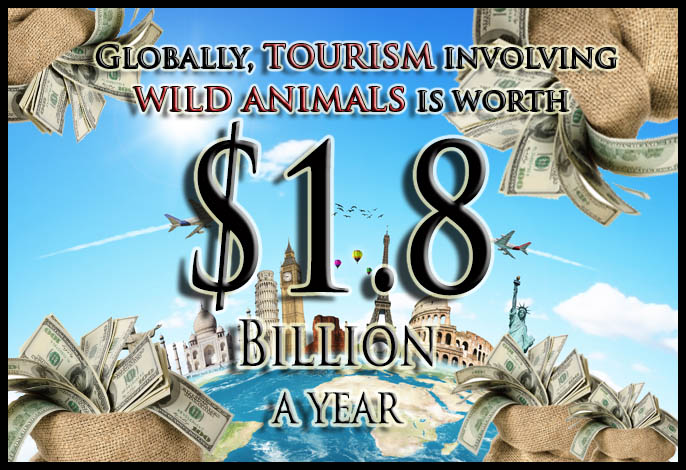
Picture: by author
Tourism isn’t necessary always bad for biodiversity, it can be a beneficial through developing conservation areas like national parks and reserves focusing on conserving species, not entertaining tourists or earning money.
The clue for us, the travelling and exploring generation, is to avoid the tourist attractions that do more harm than good.
When out travelling, local venues will give you the opportunity to ride an elephant, walk with lions or even get some great selfies with a tiger cub. You could have the time of your life while visiting these venues and getting close and personal with the animals, but what most people might not realize is that a “once in a lifetime” photo means a lifetime of misery for the animal involved.
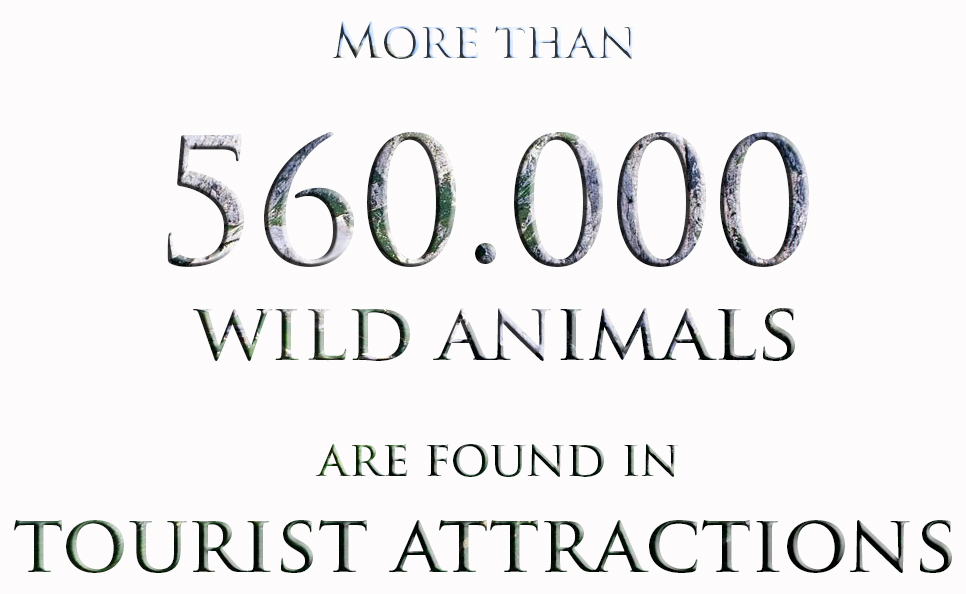
Picture: by author
DO NOT BLINDLY TRUST TOURIST REVIEWS

Picture: by author. When people leave reviews on Tripadvisor, they’re mainly all positive even if animal cruelty is found. This goes to show that people are not aware of the cruelty behind the scenes.
The World Animal Protection recently published a comprehensive report highlighting the gruesome and hidden story behind wildlife tourism, uncovering that over half a million animals suffer due to irresponsible tourist attractions.
It is difficult to know if the venue you visit as a tourist inflicts cruelty on animals, but chances are that it does. Welfare or conservation abuse is found in 3 out of 4 attractions
The problem with tourists being uninformed is reflected on reviews found on travel and holiday web pages like Tripadvisor, the largest online tourist review site in the world, which results in new tourists making the same mistake as the ones before them.
Pages like Tripadvisor should take action against animal abuse and flag any tourist attractions with claims of animal cruelty in order to make it easier for travelers to avoid such venues.
The irony is that those participating in activities that harm animals are often those who love animals and wish to make fun memories with them.
When informed about the suffering involved, tourists are no longer interested in taking part in the activities offered.
This shows how important it is to inform people about what is going on.
WHAT CAN I DO?

This post will provide a summary of the World Animal Protection report regarding animal cruelty, and give you a top 10 list of what to avoid when out travelling.

Contrary to what most people might think, elephants are one of the most dangerous animals to handle and are therefore forced through a horrible training process (known as the “crush”) from a very young age.
This training process involved tying the animal in chains or ropes in a small cage, making it impossible for the animal to move, while inflicting the animal with pointed metal bull hooks to establish dominance. The animal is only allowed to move whenever the person in charge commands, and this process continues for up to a week, making sure to break the spirit of the animal so that they will accept people riding on their back.
For the rest of their adult lives, the elephants are prevented from forming natural social relationships with each other, often chained in small enclosures when they are not taking tourists for a walk. These animals are given little veterinary care and can suffer for a long time before being put down.
There are no such thing as happy, free elephants giving humans a ride – they all go through a process of mental breakdown in order to be taught submission and obedience.
Large travel companies around the world are now banning elephant rides as part of their holiday deals, some of them being Apollo, World Expeditions, TUI Nederland, Interpid Travel and Albatros Travel.



Picture: by author. IUCN list info (press picture)
Tiger cubs are taken from their mothers at the youngest age possible so that they can be used as props for people wanting a great selfie.
They are handled and hugged by tourists all day long, being drugged to keep calm, and then kept chained in small cages the rest of the day.
To make sure the tiger cubs can’t do any real harm, they will have their sharper teeth pulled out as well as claws removed, both of which are extremely painful procedures.
While many attractions claim to be sanctuaries, any place planning to release animals back into the wild would not allow them to be handled by the public, especially tourists, as they would not survive in the wild.


As with tigers, lion cubs are bred and taken away from their mothers within a month of birth. While they are still rather small in size, the cubs are being handled by tourists that wants to pose for photos and are hit if they show any signs of aggressive or unwelcome behavior.
As they get older and grow too big to be picked up or handled by tourists they are used in a rather new tourist experience: walking with lions. Here the lions are trained to walk with tourists, being punished if they misbehave, and face a lifetime in captivity as they are not capable of living on their own in the wild.
There is, unfortunately, a larger tourist marked for lion cubs than for adult ones, opening up for another marked: canned hunting, which you can read more about here.


In bear parks, the bears are kept in sterile “pits” in great numbers, having little to no behavioral enrichment.
Bears are mainly solitary animals in the wild, and so gathering several of them together in a small enclosure usually leads to a lot of fighting and nasty injuries.
Living in large groups and being exposed to a lot of stress increase the susceptibility to diseases caused by bacterial infections, and bears can be sick for a long time before receiving any medical treatment.
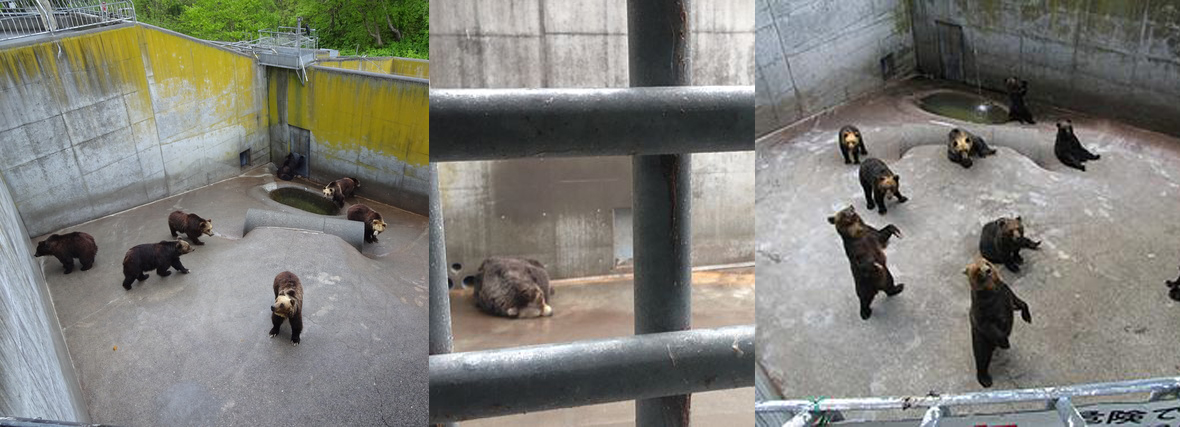

There is only one remaining sea turtle farm in the world which allows for tourists to handle turtles and even eat them during their visit, and that is in the Cayman Islands.
When handled by tourists, turtles often panic and intensively flap their flippers, causing fractures and detached claws. They are also under a great deal of stress which weaken their immune system and thus increase their susceptibility to diseases.
As most people don’t know how to handle them, many tourists accidentally drop the struggling sea turtles resulting in serious injuries or death
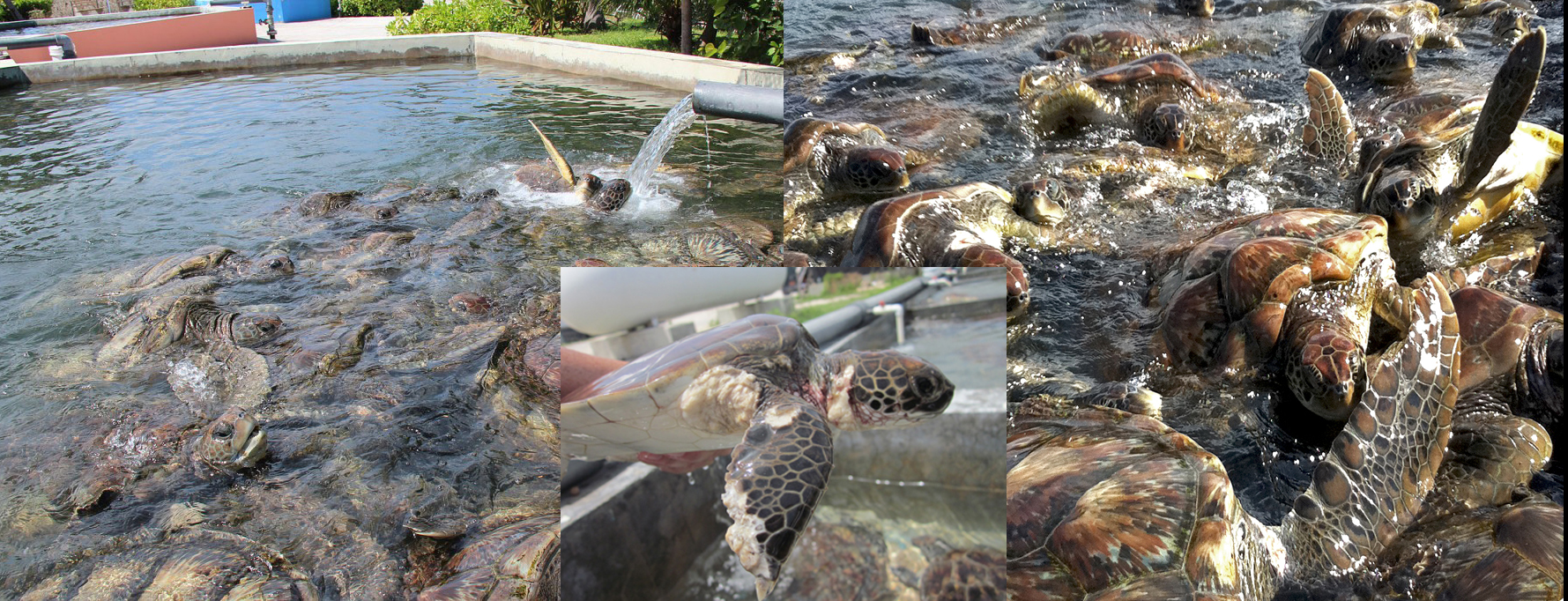

When catching dolphins, high speed boats usually chase a group of individuals before hauling on board some of the most desired ones (usually a certain size or color), even catching them in nets. Usually, the stress is too much for the dolphins to handle and they die during the transportation.
The dolphins, whether they are born in captivity or caught in the wild, face a lifetime of suffering. Their pool is usually the size of a swimming pool which is often treated with chlorine, thus causing painful irritations to the eyes and skin
They also suffer from sunburns, as they are unable to escape to waters deep enough to avoid the strong UV lights.
Dolphins have a highly tuned echolocation which is used for navigation in the wild, but is interfered with by the flat walls of the pool, making it impossible to navigate as they would in the wild. Many dolphins die of stress-related illnesses such as gastric ulcers and heart attacks.
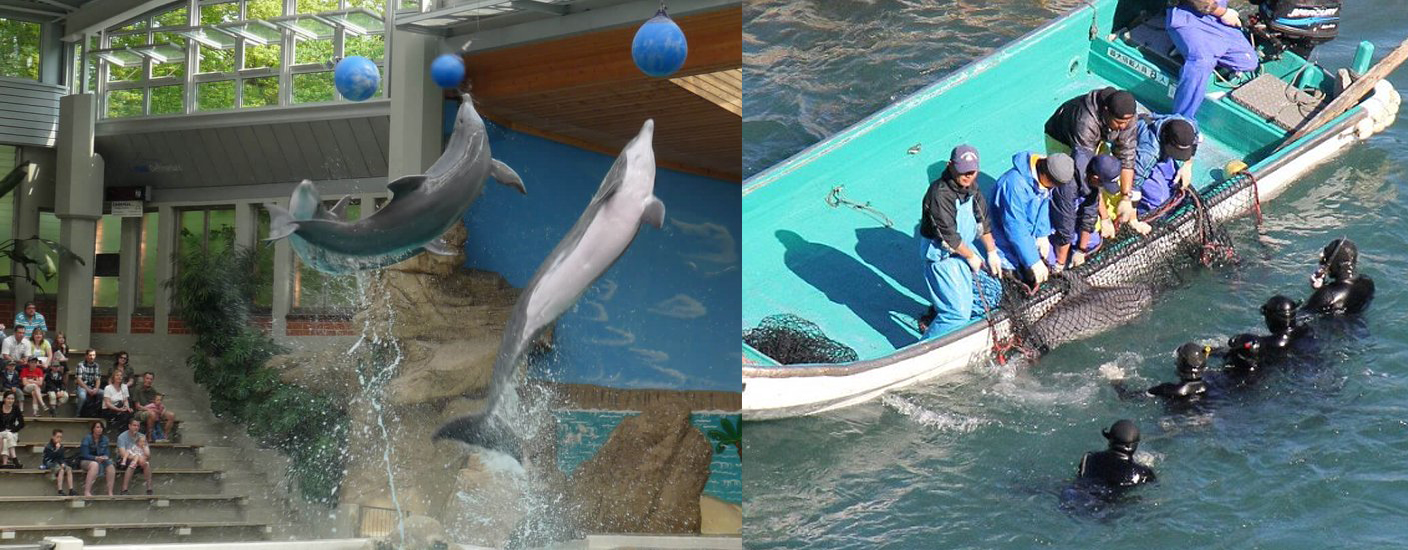

There are many different species of primates being used for street entertainment, the largest group of species being macaques. They are trained in an aggressive and painful way to make them act more human-like, by walking on two feet and dancing or performing tricks for groups of tourists.
The macaques are often equipped with a collar and chain when caught as young, and as they grow the chain becomes more embedded in the skin leading to painful wounds, infections and sometimes death.
When they are not performing, the animals are kept chained up in small cages in groups, or outside on short chains.


Civets in the wild eat coffee cherries and excrete the coffee bean within the cherry in pellets. This has then been collected in the wild to make civet coffee from the excreted bean and is a luxury coffee selling for over 500 NOK ($100) for one cup.
The pellets used to be collected in the wild, but as the tourist demand for this luxury coffee increased, locals started catching civets from the wild and keeping them in small, crowded cages. Here the civets are force fed coffee cherries in large quantities and suffer both nutritional and physical injuries.
As civet coffee has become a growing tourist industry, “farmers” of the coffee have started giving tours around the plantations, resulting in more and more civets being caught, caged and abused.


Snake charming is an old street entertainment usually involving cobras.
The latest twist on this old tourist attraction is to let tourists kiss the cobra to get some unique holiday photos.
Cobras are caught in the wild, defanged with metal pliers and have their venom ducts either removed completely or blocked. This is done without any sanitary equipment, often resulting in deadly infections.
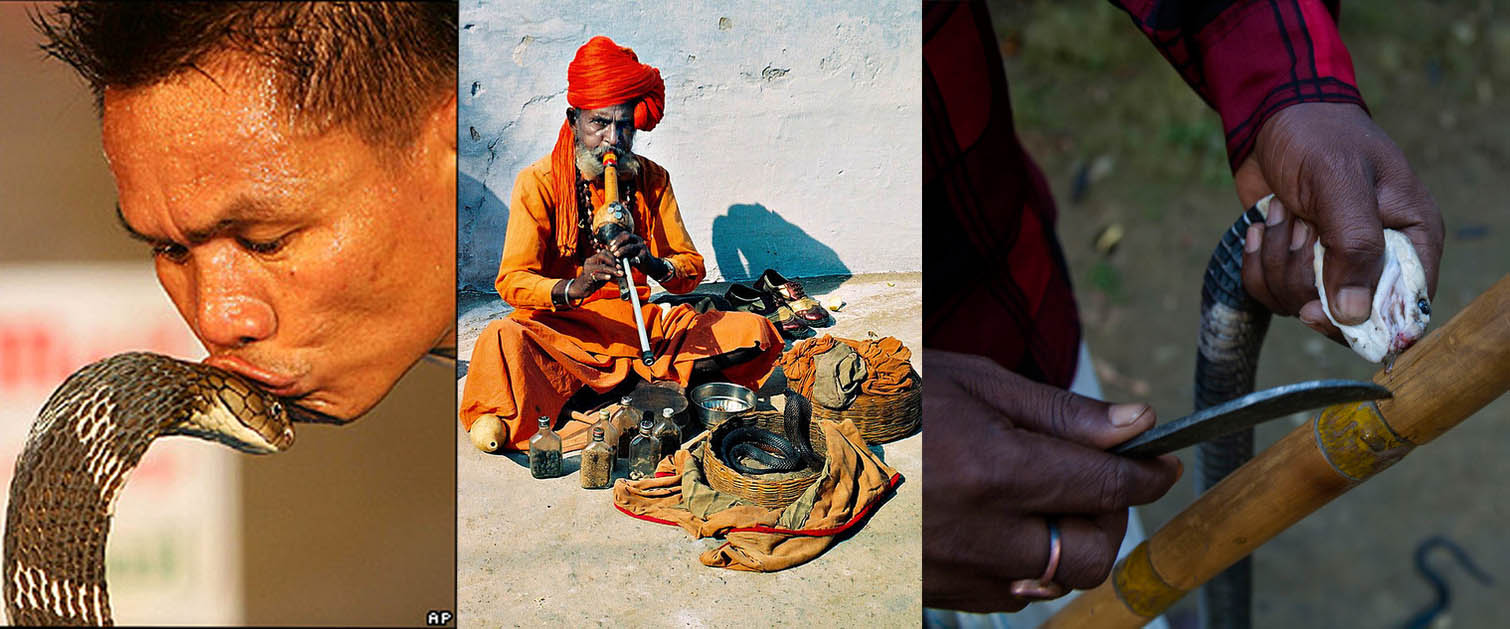

A large number of crocodile farms are providing the fashion industry with skins, and these farms are becoming a larger part of the tourist industry giving tourists an opportunity to come see the animals and also eat them in on-site restaurants.
Crocodiles are usually kept in concrete pits, with these pits being filled to the rim, and are so unhygienic and appalling that the conditions alone often are enough to kill the crocodiles. As they are very sensitive to stress, their immune system can decrease to such an extent that they are unable to fight off infections and thus fatal diseases develop.
As the pits are severely overcrowded there is a limited availability for food and water and the crocodiles will often fight each other to the death or severely injure each other which eventually kills them too.

It might seem a bit depressing reading through this list, but if you’ve read this far, make sure to read the rest.
There are some places you can go to get the ultimate wildlife experience without having to feel bad for doing so

BORNEO ORANGUTAN SURVIVAL FOUNDATION (BOSF):
Samboja Lestari Eco-Lodge

BOSF is a leading orangutan rescue organisation located in Indonesa that takes in and cares for orangutans who have been used in the entertainment industry, kept illegally as pets, been orphaned in the wild or lost their habitat.
They have rescued over 2200 orangutans since they started in 1991 and provide care and rehabilitation for around 700 individuals.
Sadly, most of the orangutans can never bee returned back into the wild due to old age, disabilities or other illnesses, but the ultimate goal is to release as many individuals back into the wild as possible.
As a tourist you get to stay at the Eco-lodge nestled in a 1.850 hectare reserve for regenerating rainforest, where the permanent orangutan residents live. You can also work as a volunteer and make behavioral enrichment devices, collecting observational data or prepare their food.
To read more about BOSF click here.

THE ROMANIAN BEAR SANCTUARY

Bears were once caught as cubs to illegally keep in small cages in venues such as petrol stations and restaurants as a way to entertain and attract customers.
The Romanian Bear Sanctuary is a safe haven for these former captive bears, where they can live in semi-natural conditions in large enclosures of around 30 hectares.
Tourists can get guided tours around the sanctuary to view the bears while being educated about the problems of captive bears used in entertainment. There are strict rules as to how to behave while in the sanctuary.
You leave the sanctuary with a sense of appreciation for these wild animals as well as a true wildlife experience.
Read more about the bear sanctuary here.
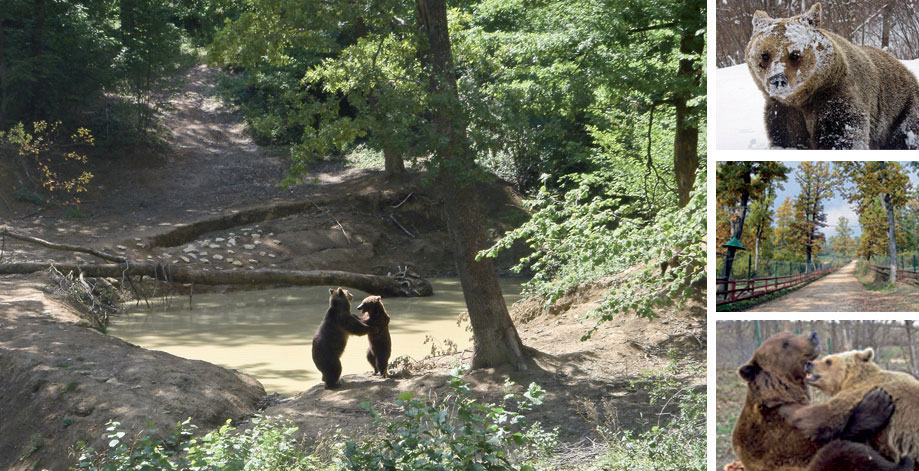
SOME QUESTIONS TO ASK YOURSELF WHEN TRAVELLING
It might still be hard to know if the attraction you want to visit is animal friendly or not. There is a travel guide providing great tips for how to be animal friendly when out travelling, which is found here.
You could also ask yourself some simple questions:
- Does this animal have food and water?
- Is there rest and shelter for the animals?
- Is the animal in pain and suffering?
- Are you observing «natural behaviour» or is it cruelty?
- Will I see animals in distress?
- Am I allowed to interact with the animals?
- Are they breeding more animals?
- What happens to the animals when you leave?
WHAT SHOULD YOU DO?

Picture: by author
Sources:
Information about the top 10 list: The full report can be read here (Accessed on the 11.02.2016)
Information about animals in tourism:
Hall, C. (2010). Tourism and biodiversity: more significant than climate change?. Journal of Heritage Tourism, 5(4), pp.253-266.
Moorhouse, T., Dahlsjö, C., Baker, S., D’Cruze, N. and Macdonald, D. (2015). The Customer Isn’t Always Right—Conservation and Animal Welfare Implications of the Increasing Demand for Wildlife Tourism. PLOS ONE, 10(10), p.e0138939.
Newsome, D., Dowling, R. and Moore, S. (2005). Wildlife tourism. Clevedon: Channel View Publications.
http://www.abc.net.au/news/2016-02-04/elephant-rides-dancing-monkeys-cruellest-tourist-attractions/7139316 (17.02.16)
Tourists view on tourist attractions with animals:
http://news.nationalgeographic.com/2015/10/151021-tourism-wildlife-welfare-conservation/ (17.02.16)
- Riding elephants
Information about «the crush»: https://journals.worldnomads.com/responsible-travel/story/81053/Thailand/Why-Elephant-Riding-Should-Be-Removed-from-Your-Bucket-List (11.02.16)
Pictures (from left to right):
http://www.alternativeway.net/blogs/activism-stories-from-the-web-worth-reading/7644599-elephant-cruelty-in-thailand (21.02.16)
http://www.balinatatour.com/elephant-ride (09.02.16)
https://jennasconservation.wordpress.com/2015/09/23/i-want-to-ride-an-elephant/ (21.02.16)
- Tiger seflies:
About tiger selfies: http://www.theguardian.com/travel/2014/jul/29/wiildlife-charity-calls-for-end-tiger-selfies (20.02.16)
https://www.thedodo.com/tiger-cub-captivity-selfies-1191868858.html (20.02.16)
Information about IUCN red list: http://www.iucnredlist.org/details/15955/0
Pictures (from left to right):
https://s-media-cache-ak0.pinimg.com/736x/ae/fe/d1/aefed1851427df5c206fee601cd406d6.jpg (Accessed 14.02.16)
http://news.yahoo.com/blogs/omg/khloe-kardashian-sparks-outrage-photo-herself-with-tiger-cub-054448769.html (Accessed 20.09.2015)
http://www.independent.co.uk/life-style/love-sex/why-guys-are-posing-with-tigers-in-their-tinder-pictures-and-why-it-wont-get-them-any-more-dates-9573833.html (Accessed 21.02.16)
- Walking with lions:
Lion hunting: http://www.bloodlions.org/ (12.02.16)
Pictures (left to right)
https://lionexploitation.wordpress.com/author/louisesanwild/page/3/ (18.02.16)
- Visiting bear parks
Pictures (left to right)
http://www.huffingtonpost.co.uk/georgina-allen/japans-notorious-bear-par_b_7865226.html (14.02.16)
http://www.wildwelfare.org/#!japan/ccma (14.02.16)
http://www.wildwelfare.org/#!untitled/zoom/mainPage/c6l0 (14.02.16)
- Holding sea turtles
http://advocacy.britannica.com/blog/advocacy/2015/11/one-of-the-worlds-cruellest-tourist-attractions/ (15.02.16)
Pictures (left to right)
http://www.hsi.org/issues/wildlife_trade/facts/farming_sea_turtles.html?referrer=https://www.google.no/ (15.02.16)
http://www.conserveturtles.org/pressreleases.php?page=n_CaymanTurtleFarm2012 (15.02.16)
http://www.paxgaea.com/CaymanIslands.html (15.02.16)
- Performing dolphins
http://www.bornfree.org.uk/campaigns/zoo-check/captive-whales-dolphins/ (18.02.16)
Pictures (left to right)
http://us.whales.org/wdc-in-action/captivity (18.02.16)
http://www.dailymail.co.uk/news/article-2257426/The-dolphin-snatchers-Mail-investigation-exposes-vile-trade-animals-sold-100-000-aquariums-suffer-unimaginable-cruelty.html (12.02.16)
- Dancing monkeys
Pictures (left to right)
http://www.dailymail.co.uk/news/article-2174350/Topeng-Monyet-Shocking-pictures-cruel-treatment-monkeys-forced-wear-masks-ride-tiny-bicycles.html (12.02.16)
http://www.care2.com/news/member/357545291/3577555 (12.02.16)
- Touring civet coffee plantations
Pictures (left to right)
http://www.earthisland.org/journal/index.php/elist/eListRead/the_truth_behind_that_crappy_cup_of_coffee/ (18.02.16)
https://projectluwaksg.wordpress.com/tag/common-palm-civet/ (18.02.16)
http://www.theguardian.com/environment/2012/nov/19/civet-coffee-abuse-campaigners (18.02.16)
- Charming snakes and kissing cobras
Pictures (left to right)
http://scienceblogs.com/corpuscallosum/2006/10/07/snake-kissing/ (21.02.16)
http://whataboutproject.com/our-friends/bangladesh/snake-charmers (21.02.16)
http://handluggageonly.co.uk/2016/01/26/heres-a-really-important-thing-you-need-to-know-about-snake-charming/ (21.02.16)
- Farming crocodiles
Pictures (left to right)
http://www.crocodileadventures.com/farm.html (22.02.16)
http://bassiounigroup.com/uncategorized/zimbabwes-crocodile-farms-lucrative-investment (22.02.16)
http://www.chiangraitimes.com/dozens-of-crocodiles-escape-in-pattaya.html (22.02.16)
Thanks for reading!
Marie Danielsen
Today we have a large population of people who are starving or suffering from malnutrition. According to the food assistance branch of the UN, the World Food Program, 45% of deaths in children under the age of five is caused by poor nutrition. They also state that in the sub-Saharan Africa, which is the region with the highest prevalence of hunger, one in four people are undernourished
As we can see getting enough food for our large human population is already a problem – and it is only going to get worse. The human population is predicted to keep growing up to 9 billion (Godfray et al. 2010).
To understand some of the problems with choosing types of food for a larger human population we need to know a little bit about different trophic levels, which ScienceDaily defines as:
“In ecology, the trophic level is the position that an organism occupies in a food chain – what it eats, and what eats it.”ScienceDaily 11/02/16
In each trophic level the organism is using most of the energy for everyday processes, and that energy is ultimately lost for the ecosystem as respiratory heat. The energy that is not lost is used to build new biomass, which is called the production efficiency. Across all species the average production efficiency is 10 %, which means that the remaining 90 % is lost between each trophic level. These numbers differ between types of organism and especially with what kind of metabolism the organism has. The production efficiency can be anything from 1% to 50%.
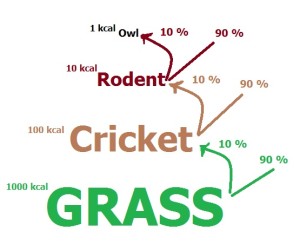
Let’s look at one example. 10 % of the energy that the grasses produce during a lifetime is possible to transfer to the next trophic level: a cricket. The growth of the cricket biomass, which is only 10 % of the energy it got from the grass, will be the source of energy for a rodent. 10 % of that energy again will be accumulated in the biomass of the rodent, which the owl will be eating. So if you start out with 1000 kcal of grass, the owl at the top will only end up with 1 kcal of this.
This helps us to understand that if we use a lower trophic level as a source for food, we can get more food for more people and less energy is lost in the food chain.
By simulating the scenario that we eat less meat Stehfest et al. (2009) have found that we could reduce the amount of pasture area with 80 % compared to our dietary habits of today. This means that we could produce more food for more people, but decrease our use of land for food production. Stehfest et al. (2009) also points out that this could have a positive effect on the climate because these former crop-landscapes would capture carbon from the atmosphere as the vegetation grow back.
It looks like one of the ways that we can solve the problem of finding enough food for a growing human population is to reduce our consumption of meat. Are we willing to do that?
Written by: Ragnhild Gya
Sources:
Begon M., R.W. Howarth, C. R. Twonsend. (2014). The flux of energy and matter through
ecosystems. In: Essentials of Ecology. United States of America: Wiley. p 309-340.
Godfray H.C.J., J. R. Beddington, I.R. Crute, L. Haddad, D. Lawrence, J.F. Muir, J. Pretty, S.
Robinson, S. M. Thomas, C. Toulmin (2010) “Food: Security: The Challenge of
Feeding 9 Billion People”. Science. 327: 812-818
ScienceDaily. (2015). Trophic level. Available:
http://www.sciencedaily.com/terms/trophic_level.htm. Last accessed 11/02/16.
Stehfest E., L. Bouwman, D.P. van Vurren, M.G.J. den Elzen, B. Eickhout, P.Kabat (2009)
“Climate benefits of changing diet”. Climatic Change. 95:83-102
World Food Program. (2016). Hunger Statistics. Available: https://www.wfp.org/hunger/stats.
Last accessed 11/02/16.
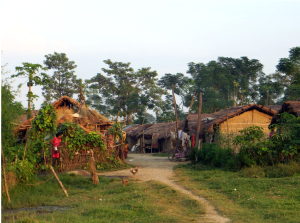
A Tharu village in the buffer zone of Chitwan National Park, Nepal. (photo: Ben Robson)
The natural world has constantly changed and developed as a result of both natural and anthropogenic influences over geological time [1], the notion of conserving and preserving landscapes for future generations is however relatively recent. In particular, a distinction exists between perceptions of how “pristine” landscapes should be conserved between the more developed “Northern” countries and the less developed nations in the “South.”
Countries in the North generally moved from a predominantly rural population to a more urbanised population during the industrial revolution, as such when national parks and conservations were established in the mid-20th century, significant populations were already settled within the new national park boundaries, thereby limiting the amount of conservation that could be carried out. National parks in Western Europe generally conform to a grade V classification according to the IUCN classification scheme (table 1), aiming to find a compromise between the needs of both mankind and nature.

75% of land within English and Welsh national parks is privately owned meaning it is seldom that pure «wilderness» is found. Activities such as farming, mineral extraction or power generation are in some cases permitted within the park, but economic activity that that could aesthetically impact the landscapes that we associate with our cultural or national identity are limited [2]. and steps are taken to preserve the building style, land-use and character of the area. For example, many would associate the Lake District National Park with William Wordsworth, traditional rustic farming, the rolling hills of England and relaxing around the lakes than they would with untouched nature. It could be argued that most British, and to an extent European national parks are therefore preserving a human-influenced landscape that we feel is in danger rather than a wilderness. Economics can be one of the biggest driving factors in establishing new parks, revenue from tourism has helped create parks in Australia, the UK and Canada during the last 20 years[2].

The Lake District, UK, has been a popular destination long before it was designated a national park in 1951. William Wordsworth famously wrote «I Wandered Lonely as a Cloud» about the area in 1802 (photo: wikipedia)
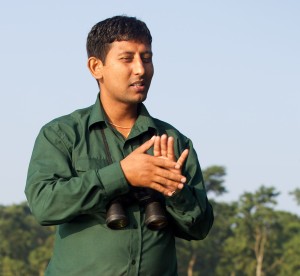
Our Tharu guide, Raju, had his father killed by a wild elephant. (Photo: Pål Ringkjøb Nielsen)
National parks in developing countries on the other hand were often established after those in industrialised nations and while a higher proportion of the population lived rurally. Some communities therefore underwent challenges to their livelihoods, or in some cases were forcibly evicted in favour of conservation [3]. Following the establishment of the Chitwan National Park in Nepal, the Tharu people faced restrictions on the amount of biomass and fruit that could be harvested, while fishing, hunting, and the amount of grazing land were also restricted [4]. Since 1964 over 22,000 Tharu have been removed from the park. Despite initial high expectations, many Tharu found the compensatory land was inadequate in terms of soil quality, resources, location and cultural value. Additionally, the re-location has affected the community social structure by mixing indigenous and hill castes [4]. The fate of the Tharu people is just one of many examples of local people being marginalised in favour of conservation, where following resettlement the population are forced to become less self-sufficient without the natural resources they previously relied upon.
It’s not just the understanding of national parks that differ between the “North” and “South” when it comes to how conservation is perceived. There is also a large distinction on how the conservation of large mammals. Despite a population of just 35 to 52 wolves, Norway kills over 25% of the population each year, and also permits the cull of bears, wolverines and even Golden eagles that have killed reindeer [5]. The wolves are exterminated based on the risk posed to farmers and their livestock. In reality however no one has been killed by a wolf in Norway since 1800 and of the 26,512 cases where farmers were richly compensated for livestock killed by wolves in 2012, only 1809 (7%) cases presented carcasses. A further 20,000 cases were rejected by the authorities [6].
That one of the world’s richest countries can kill a “critically endangered” species seems contradictory when you consider how Norway is an avid supporter of conservation in the developing world. Human-wildlife interactions are a serious problem in Nepal where 21 people were killed by wild elephants between 2008 and 2012 [7] while crops such as rice, lentils and wheat are frequently damaged by wild animals [8]. Some have argued that if less developed countries were to use similar tactics for protecting their agricultural livelihoods there would be widespread commendation [6].
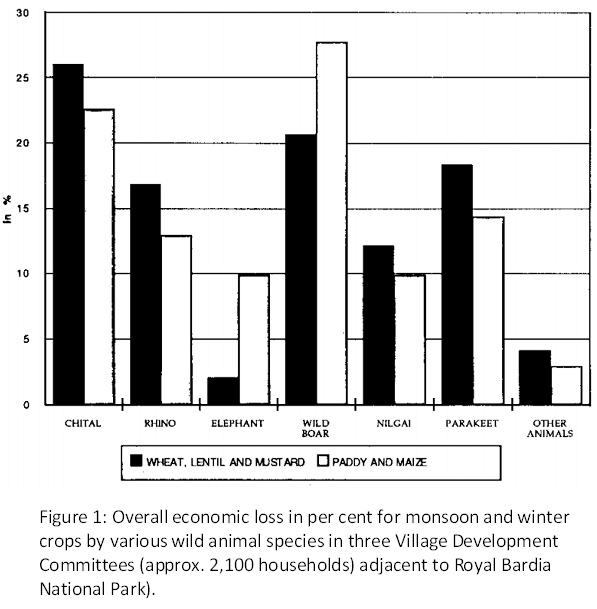
Of course, the Scandinavian countries do many great things for conservation both at home and abroad, but I think that if conservation of nature is to be addressed on a global scale then we need a global consensus of how to construe conservation. We need to decide what landscapes we are conserving and whether they should be conserved due to their importance for wildlife and nature or due to their cultural value to us and whether there should be a distinction in conservation techniques between landscapes. Similarly we cannot expect poorer nations to act on our public perception and advice concerning conserving of large mammals when we take such drastic action on curtailing animals perceived to be a threat within our own territory.
- Hannah, L., et al., Conservation of biodiversity in a changing climate. Conservation Biology, 2002. 16(1): p. 264-268.
- Woods, M., Rural geography: Processes, responses and experiences in rural restructuring. 2004: Sage.
- Brockington, D. and J. Igoe, Eviction for conservation: A global overview. Conservation and society, 2006. 4(3): p. 424.
- McLean, J. and S. Straede, Conservation, relocation, and the paradigms of park and people management – A case study of Padampur Villages and the Royal Chitwan National Park, Nepal. Society & Natural Resources, 2003. 16(6): p. 509-526.
- Monibot, G., Norway’s plan to kill wolves explodes myth of environmental virtue, in The Guardian. 2012: London.
- McPherson, B., Den norske ulveløgnen, in Aftenposten. 2013: Oslo.
- Pant, G. and M. Hockings, Understanding the Nature and Extent of Human-Elephant Conflict in Central Nepal. 2013.
- Studsrød, J.E. and P. Wegge, Park-people relationships: the case of damage caused by park animals around the Royal Bardia National Park, Nepal. Environmental conservation, 1995. 22(02): p. 133-142.
The oceans are greatly impacted by anthropogenic inputs, but are under-sampled. Despite indications that marine species appear to be responding as or more rapidly to global change than terrestrial species [1], only 11% of studies in the fields of ecology, conservation biology and biodiversity (1996-2004) concerned marine systems, and this is evident in large syntheses such as IPCC reports (Fig. 1; [2]). Well-known and widespread drivers of ocean change are overfishing, acidification, nutrient pollution and global warming, but there are many others [3] which receive less attention. These could lead to rapid ecosystem change, altering the provision of services we depend on such as food, water purification, or habitat for fished animals.
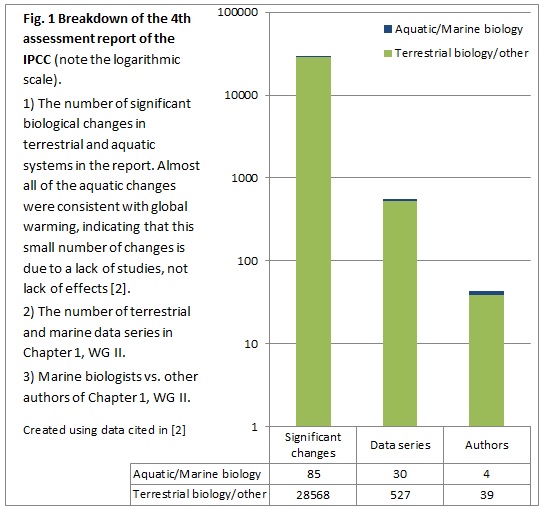
We understand ecological change in some marine systems fairly well. For example, kelp forests provide habitat for many seaweeds and animals, but can abruptly change into ‘barrens’ – mostly bare rock. Overfishing is an important driver – once it reaches a certain level, predators (such as cod or lobsters) become too rare and the urchin population explodes, eating all the kelp and preventing regrowth ([4]; and see this great video clip from the BBC). Coral reefs are another system where we have some understanding of large changes; once ocean acidification reaches a certain point calcification rates of corals will drop rapidly, as will coral survival at around 2 °C warming (see [3] for a summary). If this is combined with overfishing of herbivorous fish and nutrient pollution, a shift from coral to seaweed dominance is likely (e.g. in Florida [5]).
However, much is left to be understood even about well-known systems as we are still not sure how drivers will interact. In some cases, high pressure from one increases the impact of another, but in others, they may resist each other. For example, warming contributes to kelp forest recovery in Norway – the urchins here can only reproduce at cool temperatures, preventing warm forests from being grazed. However, in other areas, climate change negatively affects kelp forests by putting thermal stress on the kelp [6], or allowing warm-adapted urchins to expand their range [4].
We are much more in the dark about other ecosystems. The deep sea is still vastly under-sampled – we know little about what is there in the first place, let alone how it may be changing. But what we do know is that it is not the species-poor, barren landscape that it was once imagined to be. For example, there are rich faunas around hydrothermal vents which may be impacted as seabed mining becomes a reality [7,8]. Evaluation of endangered species by the IUCN also reflects lack of marine knowledge – only 9.8% of species on the red list are marine, with many species listed as ‘data deficient’ because it is difficult to get the required level of data for assessment [9]. This is a problem with terrestrial species too, but to a lesser degree than marine species – the result of this is that the extinction rate appears lower than it should be for the oceans [10], which can have effects on conservation priorities.
Some little-understood marine threats also have potentially large consequences. For example, we are aware that there is huge plastic pollution in the oceans but 99% of it is unaccounted for – we just don’t know where it is. There is a possibility that it could be accumulating biologically [11], which could have other serious knock-on effects. Chemical pollution such as PCBs can stick to plastics, thus enter the food chain more easily. PCBs themselves may be related to mass mortality events of fish or marine mammals, by increasing their susceptibility to infectious disease [12].
Conservation of the unknown
Some reasons for the lack of knowledge are practical difficulties in getting observations, poor sampling, lack of funding, and the gap between marine and terrestrial ecology [2]. These issues will have to be tackled if specific, knowledge-based conservation strategies are desired. This is possible already in some well-studied systems, where processes are sufficiently understood to allow ecosystem services-based approaches to management [e.g. 13]. For other systems, good goals could be to get knowledge to a level where we can improve the red-list for marine species, and estimate thresholds of human impacts under which ecosystems are ‘safe’. These have the advantage that they give limits and categories, which are easily communicable to policy-makers. Ways of doing this with little data may have to be developed; for example, assessing which species are threatened based on human impacts and species distribution rather than detailed, hard to get knowledge about numbers [9]. The precautionary principle can also be used – limitation of an activity because it is suspected to cause harm – but in a world where resources are limited and there is money to be made from using the environment, this can be hard to justify without enough facts.
Caroline S. Armitage
References
[1] Poloczanska ES, Brown CJ, Sydeman WJ, Kiessling W, Schoeman DS, et al. (2013) Global imprint of climate change on marine life. Nature Clim Change 3:919-925
[2] Richardson AJ, Poloczanska ES (2008) Under-Resourced, Under Threat. Science 320:1294-1295
[3] Duarte CM (2014) Global Change and the Future Ocean: A Grand Challenge for Marine Sciences. Frontiers in Marine Science 1:1-16
[4] Ling SD, Johnson CR, Frusher SD, Ridgway KR (2009) Overfishing reduces resilience of kelp beds to climate-driven catastrophic phase shift. Proceedings of the National Academy of Sciences 106:22341-22345
[5] Trivedi, B.P. (2001) Why is seaweed killing Florida’s coral reefs? National Geographic News: http://news.nationalgeographic.com/news/2001/08/0823_TVseaweed.html [Accessed 10.02.2015]
[6] Rinde E, Christie H, Fagerli CW, Bekkby T, Gundersen H, et al. (2014) The influence of physical factors on kelp and sea urchin distribution in previously and still grazed areas in the NE Atlantic. PLoS ONE 9(6) DOI: 10.1371/journal.pone.0100222
[7] Moskvitch, K. (2014) Health check for deep-sea mining. Nature 512(7513).
[8] Shukman, D. (2014) Deep sea mining licences issued. BBC News: http://www.bbc.com/news/science-environment-28442640
[9] Peters H, O’Leary BC, Hawkins JP, Roberts CM (2015) Identifying species at extinction risk using global models of anthropogenic impact. Global Change Biol 21:618-628
[10] Webb, T. and Mindel, B.L. (2014) Global patterns of extinction risk in marine and non-marine systems. Current Biology 25:1-6.
[11] Chen, A. (2014) Ninety-nine percent of the ocean’s plastic is missing. Science magazine, June 2014: http://news.sciencemag.org/environment/2014/06/ninety-nine-percent-oceans-plastic-missing [Accessed:09.02.2015]
[12] Handoh, I.C., Kawai,T. (2014) Modelling exposure of oceanic higher trophic-level consumers to polychlorinated biphenyls: Pollution ‘hotspots’ in relation to mass mortality events of marine mammals. Marine Pollution Bulletin 85(2):824-830
[13] Rogers A, Harborne AR, Brown CJ, Bozec Y-M, Castro C, et al. (2015) Anticipative management for coral reef ecosystem services in the 21st century. Global Change Biol 21:504-514
Nowadays in the greater part of Europe food is something trivial, something omnipresent, something you don’t waste time to think about it’s origin. You just buy it in the supermarket and then you eat it. That’s it. Of course people are thinking and talking about food all the time, but if we are honest, it is more about, what we want to eat and what we should eat in order to maintain or gain our dream body. I can’t remember the last time, I had a conversation with a friend about how this trivial thing „food“ is produced, or even more: Which consequences could it entail to domesticate and tame not only crops and animals in order to gain food, but to domesticate whole landscapes in order to increase food production? And furthermore, what tradeoffs are we willing or not willing to accept in order to satisfy our everlasting desire for what we are used to: food at any given time and in any amount.
The fact alone that around 24% of the Earth’s terrestrial surface is occupied by cultivated systems, in order to satisfy the increasing demand for food, feed and fibre(1), makes it quite clear that the question of foodproduction is a very important one, when it comes to man-made landscape change. Therefore I decided to discuss some major points of the article „Domesticated Nature: Shaping Landscapes and Ecosystems for Human Welfare“ by Peter Kareiva et al.(2) in my blog.
In order to see the topic of domestication and land-use in general a bit more in context, I had a closer look on the planetary boundaries. In figure 1 you can see an illustration for the planetary boundaries, which are showing the risks of destabilizing the Earth system, as we know it in the Holocene, at a planetary scale. (3) As you can see Land-system change is one of the areas, that already have reached the zone of increasing risk, which means, that it has exceeded the boundary. Moreover, the area of Biochemical flows, which is by fertilization closely related to intensive cultivation of crops, is already in the high risk zone. Especially the nitrogen cycle is strongly out of balance.
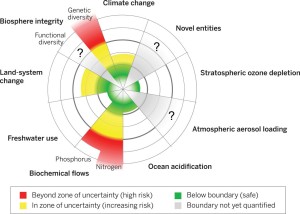
Figure 1: Shows the exceeded and not exceed boundaries of the earth system. picture from: see (3) (http://www.sciencemag.org/content/347/6223/1259855.full)
Nevertheless, the reasons why humans are domesticating landscapes are easy to understand: The three main goals of domestication are increased overall productivity, promoted commerce and protection from predators and nature events, as for example storms.(2) If you only consider these three aims, then domestication is significantly enhancing the well-being of humans. But we must not forget, that there is a known price we pay for these benefits and what is perhaps even more important, that there could be so far undiscovered risks. Therefore it is most crucial to go on researching in this field, so that the tradeoffs in ecosystem services can be better understood. This is the only way I see to decide, what is a desirable management of these tradeoffs, not only for now, but also with regard to future generations.
In order to illustrate, what is meant by tradeoffs, I have chosen one example mentioned in the article for each of the three aims. The first example has the aim to maximize productivity. As mentioned before the nitrogen cycle has been strongly damaged in order to reach an increase of food production. The massive use of fertilizers in agroecosystems leads to water pollution and as a consequence to destroyed coastal zones and algal blooms (2). An example for the impacts and tradeoffs, resulting from our pursuit of promoted commerce, is the rapid spread of deseases and invasive species, indebted by the enhanced trade. (2) The third and last example is an example for the aim to avoid risks: By the removal of top carnivores, the danger for hikers, farmers and ranchers to get attacked is decreasing. But on the other hand missing predators, can lead to an enormous increase of herbivore populations, which can cause overgrazed landscapes and other damages to the ecosystem.(2) At least after these examples we can see, that the idea of tradeoffs in ecosystem services is not only crucial but also quite complex, what makes it most likely, that there are still tons of unknown consequences of domestication.
In the debate about what the best form of stewardship for the nature is, the first idea probably most people have in mind, is the conservation of wild and pristine nature.
But because of the fact, that today only 1% of the Earth’s terrestrial surface is set aside as real wilderness (4), this is quite utopian. Moreover, I think that this idea also neglects that humans will always do, what benefits them the most. Basic human needs, like food, will always be rated higher than other desirable matters.
For me that means, that we need to spend more money on research of tradeoffs and that we need to do a greater affort to understand how the ecosystems, that we are shaping, are working. This can give us better awareness of how our decisions are influecing not only the ecosystems by themselves, but also the current and prospective well-being of humankind. This personal opinion of mine fits well together with the conclusion of Kareiva et al., that an understanding of tradeoffs made in ecosystem services is important, in order to do the step away from only trying to protect nature from human influences, towards a well-conceived management of tradeoffs among ecosystem services, from which humans and nature can simultaneously thrive. (2)
By: Bianka Mertins
References:
(1) Millennium Ecosystem Assessment, Ecosystems and Human Well-Being: Current State and Trends, Chapter 26, Island Press, 2005: http://www.unep.org/maweb/documents/document.295.aspx.pdf (accessed: 16.02.2015).
(2) Kareiva, P., et al., Domesticated Nature: Shaping Landscapes and Ecosystems for Human Welfare, Science, 2007.
(3) Steffen, W.,Planetary boundaries: Guiding human development on a changing planet, Science, 2015: http://www.sciencemag.org/content/347/6223/1259855.full (accessed:16.02.2015).
(4) UCN,World Database on Protected Areas(IUCN, Washington, DC), 2007.
Plants growing on high mountains are often expected to be among the first losers of the global change. When a species’ habitat changes critically the species has three options: migrate, adapt or die. Parallel with the temperature increase of the last decades, we have seen plant species migrating upwards towards colder habitats. But for high-alpine species migration is not an option as they are already sitting at the last stops – on the highest peaks. However, even after decades of climate change there have been surprisingly little extinctions. Fast adaptation maybe? No, unfortunately part of these species is already using overtime. I say overtime because their extinctions are only delayed after the disturbance, in this case climate change and increased competition (1). Extinction debt is what we call the sum of all the species with delayed extinctions (1).
Scientists modelling future distributions for alpine plant species have found out that a species might remain in its old habitat even 50 years after the habitat has changed unsuitable for the species (2). This tendency towards high delay in extinctions in high-alpine regions is mainly due to longevity of these species. Even if new plant individuals are not able to survive anymore because the habitat has gone through too much change, the old individual may remain after decades. But to be able to remain in the old habitat in the long run, the species would also need to adapt to the new environment, and for alpine specialists with long life cycles this seems very unlike.
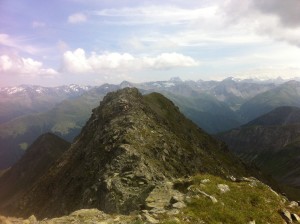

Figure 1. Left: Chummer Schwarzhorn, a mountain top in South-Eastern Swiss Alps. Right: Glacier buttercup, a typical high alpine species feared to go extinct, growing on the same mountain. Pictures by Aino Kulonen.
Mountain tops are of great interest because changes in diversity have been fast and well reported, but after all, they represent an extreme environment, covering only a small part of earth land area and small part of total biodiversity. Indeed, we should be even more scared of underestimating the extinction risk and losing essential parts of our biodiversity everywhere. Recently it has been shown how entire Europe is carrying a heavy extinction debt on its shoulders (3). And now we are not only talking about some pretty flowers whose beauty mainly mountaineers would be able to enjoy, but hundreds of species including mammals, reptiles, insects and plants.
A practical way to investigate regional extinction risk is to look at red list species. Red lists contain species that are announced to be endangered in national level. In a recent study national proportions of endangered species were compared with the pressure these countries have put on their ecosystems in years 1900, 1950 and 2000 (3). This pressure was measured as socioeconomic activity; population density, per capita GDP and intensity of land use (Fig 2). The result is alarming: for most taxonomic groups current numbers of endangered species are mirroring the pressure for ecosystem from 1900 and 1950. This means that today’s endangeredness and extinctions are results from the damage done by human already a century ago. The extinction risks we measure today are lagging 50-100 years behind human activities.
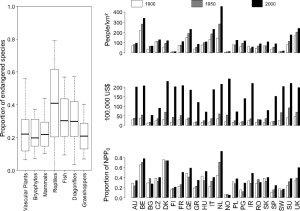
Figure 2.Left: Proportions of species facing medium-to-high extinction risks in national red lists in 22 European countries. Right: Trends in three socioeconomic indicators in Europe (human population density in people per square kilometer; per capita GDP in 100,000 International Geary–Khamis dollars; and human appropriation of net primary productivity, which is defined here as the proportion of the total net primary productivity harvested by humans to the net primary productivity of the potential vegetation (NPP0). Figure from reference 3.
The delay in extinction risk is longest for vascular plants, bryophytes, dragonflies and grasshoppers. For long living plants, long lag is not a surprise but one would think that short living insects would correspond to habitat change faster. However, simulations have shown that insect populations could show a delay of over a century even when their habitat network has been reduced close to the extinction threshold. This might be the case in Europe where agricultural landscape is a matrix of intensively used land area and near-natural habitats. Proportions of endangered fish species are the only ones that mirror best the current pressures to the ecosystem. Fish populations might indeed suffer most directly from anthropogenic actions like water pollution and management of water systems. Proportions of endangered mammals correspond well to both 1900 and 1950’s socioeconomic activity. Shorter delay is explained by their bigger habitat sizes. Fragmentation and degradation of big habitats make species meet their extinction thresholds faster than by species with small habitats.
As the pressure for ecosystems has steadily increased after 1900, we are carrying an extinction legacy that might be massive and almost impossible to measure. The study presented here is based on direct human activities, habitat fragmentation and environmental degradation like pollution (3). Novel pressures for environment like climate change, nitrogen and acidic depositions together with invasions of new species are likely to interact with direct effects and even intensify environmental degradation. With all these different direct and indirect drivers, long lag-times blur the picture and makes it harder and harder to see what is actually causing the extinction of certain species. We might easily target completely wrong drivers with our actions.
Red lists in national and global level might be way too optimistic, because they use criteria like size and recent reduction in population and range (3). Even if the current state of a species seems fine to us, the species might be doomed to extinction already decades or even a century ago. And once we notice that something’s wrong, our attempts to improve the situation might come decades too late (3).
Good news is that once we have a broader perception of the extinction debt, it will be easier to direct conservation efforts to regions and species groups with the greatest debt. As long as a species exists there is hope to save it by habitat restoration and landscape management (1). But if the driver of extinction on mountain tops really is climate change, it is harder to act directly and fast enough to save these vulnerable species. Just like shrinking glaciers, endangered mountain plants seem to work as a touchable proof of global change, but how will we save them? Are botanical gardens our only hope to save samples of these species from increasing temperatures and competition?
by Aino Kulonen
References
- Kuusisaari et al. (2009). Extinction debt: a challenge for biodiversity conservation. Trends in Ecology and Evolution 24: 10, 564-571.
- Dullinger et al. (2012). Extinction debt of high mountain plants under twenty-first-century climate change. Nature Climate Change 2, 619-622.
- Dullinger et al. (2013). Europe’s other debt crisis caused by the long legacy of future extinctions. Proceedings of the Natural Academy of Sciences 110:18, 7342-7347.
Fra tid til annen hører man forskere fortelle om hvordan vegetasjon og klima har vært i tidligere tider, men det blir ikke alltid forklart hvordan man kommer frem til dette. Flere fagdisipliner (zoologi, meteorologi, oseanografi, geologi m.fl.) er som regel involvert og ofte er botanikk en av vitenskapene som ligger til grunn.
Når man hører ordet botanikk tenker man kanskje på det man ser rundt seg i skog, eng og hage, men at man med utgangspunkt i botanikk kan finne ut hva som vokste i et område og hva slags klimatiske forhold det var der for flere tusen år siden ved hjelp av innholdet i en myr eller en innsjø er kanskje ikke noe man reflekterer over til daglig. Denne delen av botanikken kalles vegetasjonshistorie og en mye brukt metode for å belyse vegetasjonshistorien til et område er pollenanalyse, en metode som har vært benyttet siden Lennart von Posts første resultater fra myrer i Sverige tidlig på 1900-tallet [1, 2]. Siden den gang har man fått bedre mikroskop og et stort utvalg av manualer for pollenidentifikasjon [3, 4 m.fl.] men grunnprinsippene for pollenanalyse som metode er fortsatt de samme; at man ved å se på polleninnholdet i en jordprøve av gitt alder kan få et bilde på vegetasjonen på det tidspunktet.
Planter produserer ofte store mengder pollen og bare en liten fraksjon av dette tar del i befruktningen av hunnplanter/-blomster. Overskuddet ender opp sammen med annet organisk og uorganisk materiale i avsetninger på land eller i vann. Over tid bygges disse avsetningene opp og selv når mesteparten av annet organisk materiale er brutt ned så vil pollen holde seg omtrent uforandret så lenge avsetningsforholdene er oksygenfri (som i en myr eller i en innsjø). Dette fordi veggen i pollenkorn inneholder kjemiske forbindelser (kalt sporopolleniner) som gjør pollen veldig hardføre mot nedbrytning. Disse forbindelsene oksideres (ødelegges) derimot lett i luft så pollen vil brytes relativt raskt ned i avsetninger som ikke har lite oksygen [3, 5].
Det er flere antagelser som ligger i bunnen for pollenanalyse som metode; en av disse er at man forutsetter at pollen fra en gitt plante ikke har endret utforming over tid, dvs. at et pollen fra en furu som blomstrer i år ser likens ut som et fossilt furupollen som er flere tusen år gammelt. En annen ting er at man antar at plantene hadde de samme kravene til levevilkår (temperatur, fuktighet, jordsmonn osv.) i fortiden som de har i dag [3].
 |
 |
| Figur 1. Mikroskopbilder av pollenkorn fra furu. Pollenkornet til venstre er 4000 år gammelt, det til høyre er 30 år gammelt. |
I en vegetasjonshistorisk undersøkelse vil man ta opp en sedimentkjerne fra et vann eller en myr og så ta ut små jordprøver nedover i sekvensen fra denne kjernen, fra øverst til nederst.
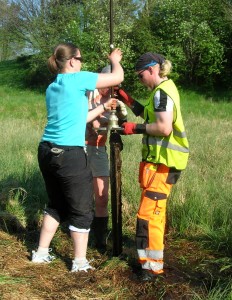 |
 |
| Figur 2. Til venstre vises prøvetaking med russerbor (en type sedimentkjerneopptaker). Foto: L.I. Åstveit. Til høyre vises en sedimentkjerne der man til høyre ser den grå bunnavsetningen. Bunnen av det brune laget er datert til 9 100 f.Kr. Foto: L.S. Halvorsen |
Fra hver av jordprøvene lager man til en mikroskopprøve der man ser på polleninnholdet (hvilke pollentyper som finnes og antallet av dem) og resultatet gis i en figur (et pollendiagram) som viser prosentfordelingen av de ulike pollentypene i hver prøve langs en dybdeakse (som også er en relativ tidsakse, eldste prøve nederst). Fra dette diagrammet kan man lese av hvor mye det har vært av hver pollentype ved en gitt dybde, og fra dette kan man få et bilde på vegetasjonen. F.eks. kan man ha 20 % bjørk, 5 % furu, 60 % gress og til sammen 15 % av diverse urter som tilsier at man har hatt en åpen vegetasjonstype f.eks. en eng med noen trær rundt.
 |
| Figur 3. Pollenprosentdiagram. Første kurve etter dybdeskalaen viser forholdet mellom trær, busker, dvergbusker og urter i pollenprøvene. I kurvene for hver pollentype viser den mørke fargen prosentverdi, den lysere fargen denne verdien x 10. Figur: L.S. Halvorsen. |
Det er også viktig å vite alderen på prøvene i en slik pollensekvens. Alderen på en prøve kan man finne ved å datere på organisk materiale (frø, planterester, trekull o.l.) funnet i sedimentkjernen ved hjelp av C-14 metoden [6,7]. Man vil ofte datere der man ser tydelige endringer i pollendiagrammet f.eks. der man har en kraftig reduksjon i treslagspollen, første forekomst av kornpollen eller lignende. Når man har dateringer så får man både et bilde på hvordan vegetasjonen har sett ut i tillegg til informasjon om når det var den så slik ut.
Fra vegetasjonssammensetningen kan man gjøre antagelser i forhold til klimatiske forhold. Dette fordi man antar at økologien til plantene man ser spor etter ikke har endret seg over tid, og man bruker det man vet om plantenes klimatiske voksekrav i nåtiden for å si noe om klima i forhistorien [3,8] og ved å sammenstille resultater av pollenanalyser fra sedimentkjerner fra flere lokaliteter kan man få et bilde på vegetasjonsutviklingen for et større landområde eksempelvis vestkysten av Norge, nordlige Skandinavia e.l. og derved kunne si noe om klimatiske forhold i det området.
For å bedre kunne si noe om klima ved slike sammenstillinger av data har man laget til datasett der man har undersøkt polleninnholdet i overflateprøver (moderne prøver) fra mange innsjøer i forskjellige klimatiske vegetasjonssoner og koblet informasjonen fra disse med temperatur og nedbørsmålinger fra klimastasjoner i nærheten av innsjøene. På den måten får man et datasett som kobler pollendata med de klimatiske faktorene for stedet [9, 10]. Dette datasettet kan så brukes som sammenligningsgrunnlag for fossile pollensekvenser og man kan få ut en temperatur eller nedbørskurve for den fossile sekvensen på bakgrunn av det man har funnet fra det moderne datasettet [9, 10, 11]. Informasjonen fra disse kurvene kan sammen med pollendataene si noe om hvordan vegetasjonen har endret seg med klima, og dette kan så relateres til klimaendringer man ser i nåtiden [12] som en pekepinn på hvordan vegetasjon kan komme til å endre seg.
 |
| Figur 4. Dette er Figur 7 fra Bjune et al. 2010 [9]. Viser rekonstruert julitemperatur og årsnedbør basert på pollendata fra Kråkenes. Brutt linje=stort (321 innsjøer) kalibrasjonsdatasett; hel linje=lite (191 innsjøer) kalibrasjonsdatasett. |
Noen av antagelsene ved en slik analyse er at man har dekket alle mulige kombinasjoner av klimadata og pollensammensetning, og at det i fortiden ikke har vært andre kombinasjoner. Det blir heller ikke tatt høyde for menneskelig påvirkning i det moderne datasettet da overflateprøvene (i kalibrasjonsdatasettet) stort sett er tatt fra innsjøer der man antar man har hatt lite eller ingen menneskelig påvirkning [9]. Mennesket har påvirket naturen i større og mindre grad spesielt siden overgangen fra jakt/fiske/samlersamfunn til jordbrukssamfunn og å inkludere informasjon fra steder der man har spor etter menneskelig påvirkning i modellene har potensiale for å gi bedre modeller for fortidens vegetasjon- og klimahistorie [13, 14].
Veien fra grunndata til klimarekonstruksjon er en lang prosess som involverer mange ulike steg. Det er viktig at man i dagens situasjon ikke glemmer at man for å styrke klimaforskingen for å få så bra modeller for fremtidige klimascenarier som mulig må huske at grunnforskingen må støttes så modellene blir så gode som mulig.
Av Lene S. Halvorsen
Referanser:
[1] von Post, L. (1916) Om skogsträdpollen i sydsvenska torfmosselagerföljder. Geologiska Föreningens i Stockholm Förhandlingar 38: 384–390
[2] von Post, L. (1918) Skogsträdpollen i sydsvenska torvmosselagerföljder. Förh. Skand. Naturforskeres 16. møte 1916. pp. 432–465
[3] Fægri, K. and Iversen, J. (1989) Textbook of pollen analysis. 4.ed. By: Fægri, K., Kaland, P.E. & Krzywinski, K. John Wiley & Sons, 328 pp.
[4] Moore, P. D., Webb, J. A. and Collinson, M. E. (1991) Pollen Analysis. 2.ed.
Oxford: Blackwell Scientific Publications, 216 pp.
[5] Sporopolleniner. Definisjon fra Store Norske Leksikon. https://snl.no/sporopolleniner
[6] Arnold, J.R. and Libby, W. F. (1949) Age Determinations by Radiocarbon Content: Checks with Samples of Known Age. Science 110: 678-680. [DOI:10.1126/science.110.2869.678]. Tilgjengelig via: http://hbar.phys.msu.ru/gorm/fomenko/libby.htm
[7] Radiocarbon: an introduction. http://www.radiocarbon.com/about-carbon-dating.htm
[8] Birks, H. J. B., Birks, H. H. (1980) Quaternary Palaeoecology, E. Arnold, London.
[9] Bjune, A. E., Birks, H. J. B., Peglar, S. M. & Odland, A. (2010) Developing a modern pollen–climate calibration data set for Norway. Boreas 39: 674-688
[10] Cheddadi, R., de Beaulieu, J.-L., Jouzel, J., Andrieu-Ponel, V, Laurent, J.-M., Reille, M., Raynaud, D., Bar-Hen, A. (2005) Similarity of vegetation dynamics during interglacial periods. PNAS 102 (39): 13939-13943
[11] Bjune, A.E., Seppä, H., Birks, H.J.B. (2009) Quantitative summer-temperature reconstructions for the last 2000 years based on pollen-stratigraphical data from northern Fennoscandia. Journal of Palaeolimnology 41: 43-56
[12] IPCC 2014. IPCC: Summary for Policymakers. Contribution of Working Group III to the Fifth Assessment Report of the Intergovernmental Panel on Climate Change. In: Edenhofer, O., Pichs-Madruga, R., Y. Sokona, E. F., S. Kadner, K. S., A. Adler, I. B., Brunner, S., Eickemeier, P., Kriemann, B., Savolainen, J., Schlömer, S., Stechow, C. V., Zwickel, T. & Minx, J. C. (eds.) Climate Change 2014: Mitigation of Climate Change. Cambridge University Press, Cambridge, United Kingdom and New York, NY, USA
[13] Paus, Aa (2013) Human impact, soil erosion, and vegetation response lags to climate change: challenges for the mid-Scandinavian pollen-based transfer function temperature reconstructions. Vegetation History and Archaeobotany 22: 269-284
[14] Trondman, A.-K., Gaillard, M.-J., Mazier, F., Sugita, S., Fyfe, R., Nielsen, A.B, Twiddle, C., Barratt, P., Birks, H.J.B., Bjune, A.E., Björkman, L., Broström, A., Caseldine, C., David, R., Dodson, J., Dörfler, W., Fischer, E., van Geel, B., Giesecke, T., Hultberg, T., Kalnina, L., Kangur, M., van der Knaap, P., Koff, T., Kuneš, P., Lagerås, P., Latałowa, M., Lechterbeck, J., Leroyer, C., Leydet, M., Lindbladh, M., Marquer, L., Mitchell, F.J.G, Odgaard, B.V., Peglar, S., Persson, T., Poska, A., Rösch, M., Seppä, H., Veski, S., Wick, L. (2015) Pollen-based quantitative reconstructions of Holocene regional vegetation cover (plant-functional types and land-cover types) in Europe suitable for climate modelling. Global Change Biology 21: 676-697
Hva er det som forteller fuglene når de skal trekke sørover, blomstrene når de skal blomstre og fisken når den skal jakte? Mange funksjoner i naturen er styrt helt eller delvis av variasjoner i lys fra dag til natt, og fra sommer til vinter. Mange dyre- og plantearter har tilpasset seg de forutsigbare lysmønsterene og regulerer metabolisme, vekst og atferd etter lysvariasjonene [1].
Hva skjer så når disse mønsterene blir brutt av kunstig belysning i byer, langs veier eller på oljeplattformer? En mye brukt definisjon av lysforurensing er at kunstig lys med intensitet større enn lyset fra månen i den første fjerdedelen av en månefase regnes som lysforurensing (se f.eks. [2] og [3]). Allerede for 14 år siden anslo man at 62% av den befolkede verden var over dette nivået [2], og 25% av den befolkede verden hadde lysforurensing som var sterkere enn lyset fra fullmånen [3].
Flere forskere anslår at kunstig belysing har enorme påvirkniger på dyre- og planteliv, men det finnes likevel få studier som har undersøkt dette [4]. Et unntak er påvirkningen kunstig lys har på fugler sin atferd hvor det finnes relativt mange studier. Flere av påvirkningene slikt lys har på fugler har du kanskje observert selv, uten å vere klar over det.
Nattaktive rødstruper
Rødstrupen er en av våre vanligste spurvefugler og en ivrig sangfugl med en lett gjenkjennelig sang. Gjennom det meste av året kan du høre fuglen synge om dagen, både i skog og mark og i byer. Etter hvert har det også blitt vanligere å høre rødstrupens sang gjennom natten i bynære områder. Forskere har undret seg over denne atferden og kommet fram til at kunstig lys er en viktig faktor [5]. Det kunstige lyset kan oppfattes som dagslys, og for en urban rødstrupe kan det virke som om dagen aldri tar slutt. For en sen nattevandrer på vei hjem fra byen kan det kanskje være fint å høre rødstrupen synge i mørket, men for rødstrupen selv kan situasjonen være svært alvorlig. Fuglen bruker nemlig så mye av sin tid og sine krefter på å synge at den glemmer andre viktige gjøremål, som å spise og sove [6].
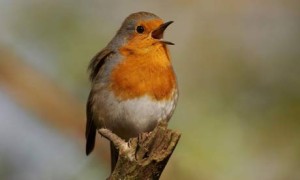
Rødstrupen er en ivrig sanger om dagen. Når kunstig lys holder den våken om nettene risikerer den blant annet vekttap og søvnmangel [6]. Foto: Neil Hardwick/Alamy [7]
Lysende oljeplattformer
Det er ikke bare i byer at det fnnes lyskilder som lyser hele døgnet. Oljeplattformene i Nordsjøen står som lysende øyer i ett ellers bleksvart hav. Mange marine fugler trekker over Nordsjøen og lyset fra oljeplattformene tiltrekker seg disse. Hvorfor fuglene blir tiltrukket av dette lyset er noe usikkert [8], men trolig kan de fleste tilfellene forklarest av at lys er viktig for navigasjonen til fuglene, samt at noen fugler tror at lyset kan bety mat [9]. Noen av fuglene kolliderer med selve plattformen, mens de fleste ender opp med å bruke store ressurser på å sverme rundt lyskilden [4].
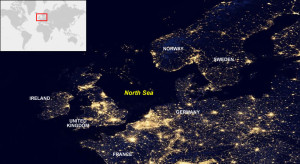
Oljefeltene i Nordsjøen er svært tydelig i mørket. Foto: NASA [10]
Mulig positiv effekt
Til tross for enda flere eksempler på hvordan fugler blir forvirret av kunstig lys finnes det også eksempler som antyder at kunstig belysing kan vere positivt for enkelte arter.
Vadefugler lever av smådyr som de finner i mudderet og er normalt bare aktive på dagtid. I strandområder som er kunstig opplyst, for eksempel av en nærliggende vei, kan vaderene utnytte det kunstige lyset til å lete etter mat, og noen studier anslår at næringsinntaket i slike områder er opp til 80% høyere enn i områder som kun har naturlig dagslys [11]. Norsk Institutt for Naturforsking (NINA) advarer likevel mot å tolke disse studiene til å vere utelukkende positive for vaderene, da de ikke omfatter potensielle risikofaktorer ved det endrede atferdsmønsteret, som for eksempel påkjøring i trafikken og økt utsettelse for predatorer [4].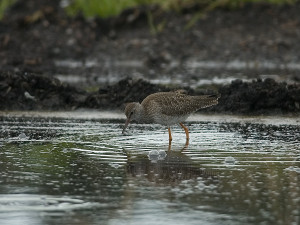
Rødstilken er en vadefugl som kan dra nytte av kunstig belysing under matsøk. Foto: Arild Breistøl
Finnes det en løsning?
Selv om de fleste studier peker mot at kunstig belysing er en negativ effekt for naturmangfoldet, er det vanskelig å forestille seg et samfunn uten opplyste veier, gater og bygninger. Kunstig lys blir også brukt til kommunikasjon, for eksempel i lufttrafikken. Det finnes likevel håp. Flere studier har sett på effekten av å endre sammensettingen i lyskildene, og resultatene er lovende [se f.eks. 4 og 8]. For eksempel har man testet ut bruken av grønt lys på oljeplattformer i Nordsjøen, og resultatet viste at antallet fugl som ble tiltrukket av plattformene ble dramatisk redusert [8]. Det er også mulig å redusere intensiteten på lyset slik at det lyser opp et mindre område, og skjerme eller vinkle lysstrålen slik at den lyser opp det området den er tiltenkt og ikke området rundt i tillegg [4].
REFERANSER
[1] Hölker, F., Wolter, C., Perkin, E. K. og Tockner, K., 2010. Light pollution as a biodiversity threat. Trends in Ecology & Evolution , Volume 25 , Issue 12 , 681 – 682
[2] Cinzano, P., Falchi, F., Elvidge, C.D., 2001. The first World Atlas of the artificial night sky brightness. – Mon. Not. R. Astron. Soc. 328: 689-707.
[3] Raven J.A. and Cockell, C. S., 2006. Influence on Photosynthesis of Starlight, Moonlight, Planetlight, and Light Pollution (Reflections on Photosynthetically Active Radiation in the Universe). Astrobiology. 6(4): 668-675. doi:10.1089/ast.2006.6.668.
[4] Follestad, A., 2014. Effekter av kunstig nattbelysning på naturmangfoldet – en litteraturstudie. – NINA Rapport 1081
[5] Kempenaers, B., Borgström, P., Loës, P., Schlicht, E. and Valcu, M., 2010. Artificial Night Lighting Affects Dawn Song, Extra-Pair Siring Success, and Lay Date in Songbirds. Current Biology. Volume 20, Issue 19, 12, Pages 1735–1739
[6] David Dominone, 2015. Upublisert. Hentet fra AAAS’s årlige møte 11.-16. februar 2015.
[7] Bilde hentet fra http://www.theguardian.com/culture/tvandradioblog/2008/feb/07/cheepandcheerfulthenewrad (20.02.15)
[8] Poot, H., Ens B. J., de Vries, H., Donners, M. A. H., Wernand, M. R., and Marquenie, J. M., 2008. Green light for nocturnally migrating birds. Ecology and Society 13(2): 47.
[9] Wiese, F.K., Montevecchi, V.A., Davoren G. K., Huettmann, F., Diamond, A. W. and Linke, J., 2001. Seabirds at Risk around Offshore Oil Platforms in the North-west Atlantic. Marine Pollution Bulletin. Volume 42, Issue 12, Pages 1285–1290
[10] Bilde hente fra http://geology.com/articles/oil-fields-from-space/ (20.02.15)
[11] Santos, C.D., Miranda, A.C., Granadeiro, J.P, Lourenço, P.M., Saraiva, S. & Palmeirim, J.M., 2010. Effects of artificial illumination on the nocturnal foraging of waders. – Acta Oecologica 36:166-
Most of the environmental problems nowadays like climate change and biodiversity loss, have one thing in common, human overpopulation. According to United Nations the world populations will reach around 9 billion people in 2050 with their ever demanding need for food and fresh water [1], prospects are not looking good. Drastic measures need to take place and in the world we live in nowadays it looks like that is not going to happen. On the climate convention in 2009 in Copenhagen it was decided that temperatures should not raise any more than 2 degrees Celsius without any nations that really wanted to give in [1]. Instead of countries trying to bring down their CO2 emissions they’ve resulted in a global trade of ‘fresh air’ . Belgium for example has spent around 194 million euros on fresh air in order to meet the Kyoto norms [2]. Public awareness is simply too low for governments to take any drastic measures, in the Netherlands for example the green minded party GroenLinks, has since foundation in 1990 never been part of the government and at the last elections they only received 2.3 percent of the overall votes [3].
Democracy seems a great way to govern a country where everybody has an equal vote, but when it comes to affairs that are greater than the wellbeing of a nations inhabitants it seems like it doesn’t work. Every party that has some drastic ideas concerning the environmental preservation, doesn’t get a place in the government because people mostly don’t care, vote in regard to their own wellbeing and they cannot directly perceive the measures a party takes because it takes a long time to notice any environmental change, let alone some ideas about population control which has been established in China a communistic country [4].
Because let’s face it the best way to preserve our environment and wildlife is not by trying to lower our ecological footprint but to control human population growth and preferably make it decline but since that is not a priority in most western countries further boundaries need to be established.
References
1. www.un.org
2. http://www.hln.be België koopt «schone lucht» vooral in het buitenland. 20/11/2013
3. www.parlement.com GroenLinks
4. http://www.telegraph.co.uk/ What is China’s one-child policy? 30/9/2014









































